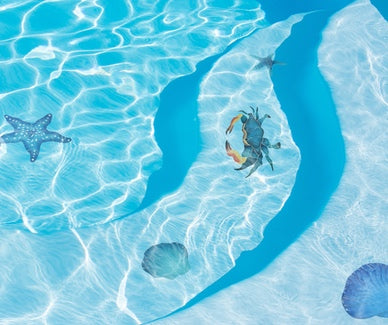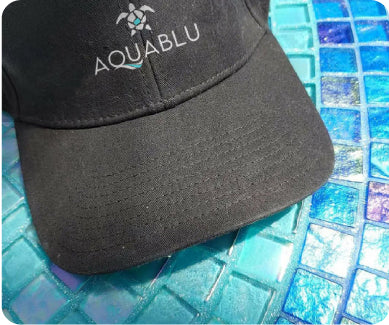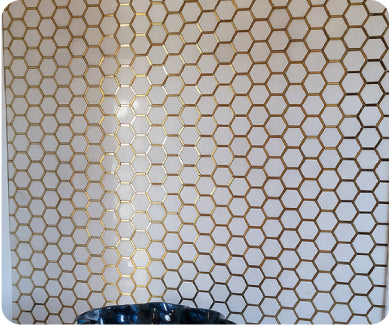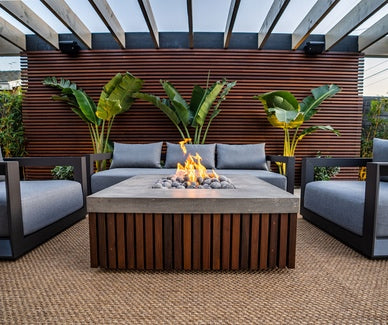Pool Tile vs. Regular Tile: What is the Difference?

Not all tile is created equally – and for good reason.
This is important to understand in order to buy the correct tile for the applications you have in mind.
For example, due to the “water, sun and rain factors,” pool tile requires an ultra-durability not necessary for interior tiles for walls or countertops which are protected from the elements. Additionally, pool tiles come into contact with chlorine and other pool chemicals. And, depending on where you live, they may also have to withstand drastically changing temperatures.
Consequently, pool tile has been specially manufactured to stand up to sunlight, changing temperatures, an aquatic environment, and constant contact with the chemicals in swimming pool water.
The consequences of using regular tile are considerable, including:
- The life of the tile will be shortened -- usually after half a year the tile will begin to fall off.
- The tile will get dirty easily and it’d be very difficult to clean after the blots penetrate into the glaze. Even if a professional pool cleaning agent is used, it’s hard to get rid of the blots.
- The glaze will fall off, be corroded, especially in spas, heated pools, and then the pool tile will fall off eventually.
There’s a common point of confusion regarding interior mosaic tile that is used around water, such as tile in the shower or kitchen backsplashes. People sometimes think because pool tile and bathroom tile get wet that there’s really no difference between them.
Wrong. While bathroom tile is designed for some contact with water, it’s not intended to be submerged 24/7. Regular bathroom tile is designed for soft lighting and steady, mild temperatures. Same goes for the tile used for kitchen backsplashes.
Want to learn more? Here’s a closer look at the differences between pool and regular tile:
Water Absorption
This is the measurement of density, porosity and specific gravity as a tool for determining the degree of maturation of a tile or for determining structural properties that may be required for a given application.
Pool tiles require a water absorption rate of ≤0.5%. This low water absorption provides firmer bond with the pool tile adhesive, which makes it difficult for pool tile to fall off. This is why pool tile is non-porous and coated with a specially formulated glaze that prevents cracking and fading.
The American National Standards Institute (ANSI) has developed a rating system for the moisture absorption of tiles. These rating are assigned based on a procedure that tests the tile’s permeability to water. It consists of boiling the tile in water and measuring its gain in weight from the original dry state.
The four different ratings for tile moisture absorption are:
- Non-vitreous (Low density) – Tile with water absorption of more than 7.0%
- Semi-vitreous (Medium density) – Tile with water absorption of more than 3.0%, but not more than 7.0%, such as ceramic tile for dry use.
- Vitreous (High Density) – Tile with water absorption of more than 0.5%, but not more than 3.0%
- Impervious (Extremely dense) – Tile with water absorption of 0.5% or less. This is where porcelain tile and glass tile used for pools applications are generally categorized.
Anti-Slip
Pool tile used for commercial applications should always be anti-slip, no matter if it’s wet or dry. Tiles are given a resistance rating to help grade the non slip level difference of a particular tile. This is known as the “R” value. R11 and R12 is the resistance recommended by many professionals for public wet areas – such as pools.
Breaking Strength
Tile breaking strength is determined in a lab setting by the American Society for Testing and Materials. A force is applied to an unsupported portion of the tile until breakage occurs. The ultimate breaking strength is then recorded in pounds. For pool tile a minimum breaking strength of at least 250 lbs. is recommended – the same for floor tiles. If you’re looking at a breaking strength lower than 250 lbs., you shouldn’t use that kind of tile on dry floors or wet (pool) applications.
Abrasion Resistance
How a tile performs under abrasion (wearing something away) also determines its optimal application. In an abrasion test, a machine rolls cylinders over a section of tile which has been covered with an abrasive substance (often white aluminum oxide) and a collection of steel balls, which vary in size between 1mm and 5mm in diameter. After a certain number of rotations of these cylinders, the tile will begin to fail (change its appearance).
The number of rotations a tile is subjected to before it fails determines its classification on a scale of 0 to 5, also known as the PEI scale. If the tile fails before 100 revolutions, it is classified at “0,” meaning it is only suitable for use as a wall tile. Tiles with higher PEI ratings are better suited for pools and floors.
Chemical Resistance
Resistance to chemicals is an important consideration in the selection of tile for a specific application. Samples of ceramic tiles are subjected to testing according to the EN ISO 10545-13 standard from 1 to 4 days, in ambient temperature, and with the usage of the following testing agents:
- Household chemicals – ammonium chloride solution of 100 [g/l]
- Swimming pool salts – sodium hypochlorite solution of 20 [g/l]
- Acids and alkaloids at low concentration (L)
The most chemical resistant tile “with no visible changes” is rated Class A – the kind you want in your pool.
Ceramic, porcelain and glass tile ratings are commonly listed on the manufacturer’s packaging. But if in doubt, just ask AquaBlu’s team of professionals who will gladly help you select the proper tile for your project.
---------------
Want to learn more about how tiles vary for different applications? Or maybe there’s something else on your mind. Talk to one of our experts. You can call us at (800) 971-1442 or fill out our contact form. Visit our website at https://www.aquablumosaics.com/.


































































































